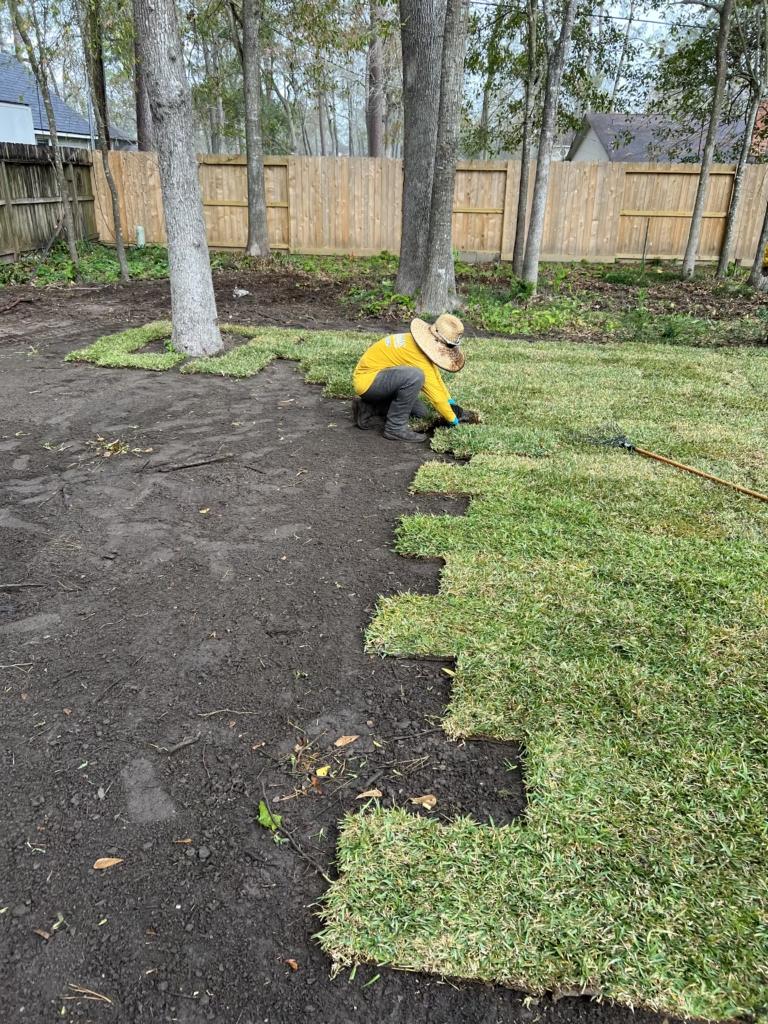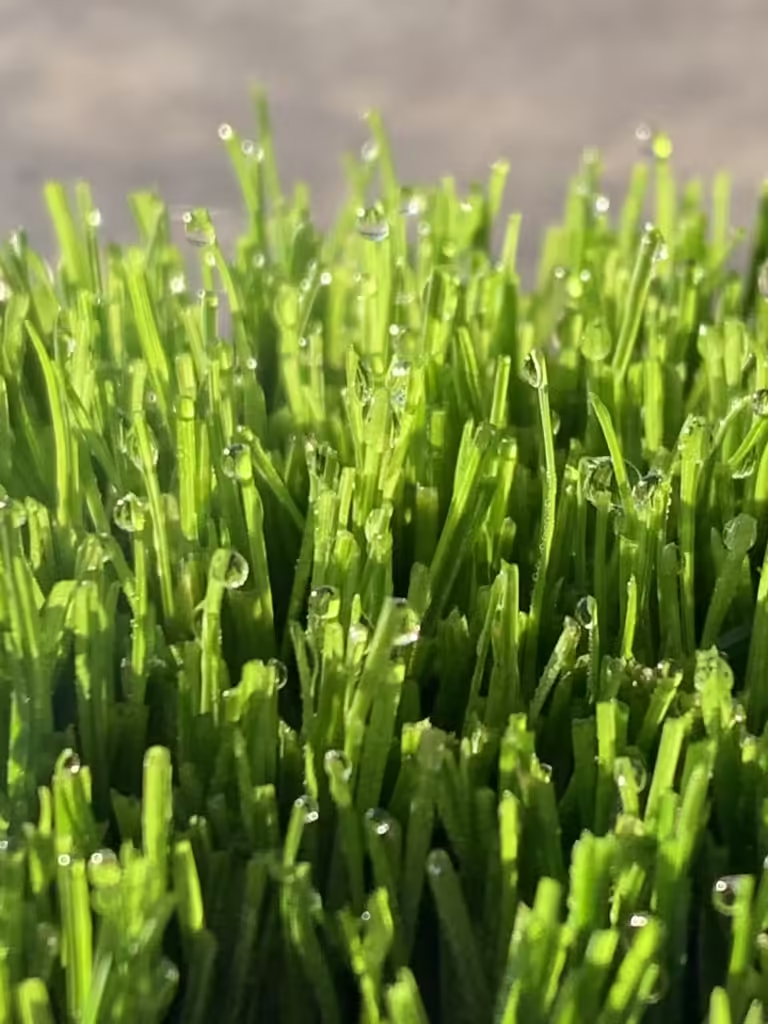
Sodding a beautiful, lush lawn is a dream for many homeowners. Achieving this dream, however, requires understanding the art and science of installing sod. This Guide to Sodding will walk you through when to install your new lawn, how to do it, and what materials you need to transform your home into a green paradise.
When to Sod: Best Time for a Healthy Lawn
Knowing the best time to lay sod is crucial for a successful lawn installation. The ideal times to sod are in the spring or fall, as these seasons offer moderate temperatures and ample moisture. Spring provides a longer growing period before summer’s heat sets in, while fall allows the sod to establish roots before winter dormancy. Although you can sod in summer or winter with extra care, it’s important to monitor weather conditions closely to ensure your sod thrives.
Additionally, in our guide to sodding, we will consider the climate of Houston Texas. In warmer areas, early spring may be preferable, while cooler climates might benefit from later spring or early fall sodding. Timing is everything, and getting it right will save you time and effort down the line.
How to Sod Your Lawn
1. Measure and Order Sod
The first step in the sodding process is accurate measurement. Make sure to calculate the lawn area carefully, accounting for any curves or irregular shapes. It’s recommended to order 5-10% more sod than needed to avoid running short during installation. Selecting the correct sod type is equally important. For example, Bermuda sod performs exceptionally well in hot, sunny climates, while Zoysia grass offers great durability and is perfect for areas with heavy foot traffic.
2. Prepare the Soil
Proper soil preparation is the foundation of a healthy lawn. Start by clearing the area of any existing grass, weeds, or debris, ensuring a clean surface. Next, grading the soil is crucial to ensure water drains away from buildings and doesn’t pool in low spots. This will prevent issues like root rot and soil compaction. Additionally, spread a layer of topsoil or compost to enrich the soil with nutrients, promoting root growth.
Soil testing should not be overlooked. Testing the soil’s pH helps determine if any amendments are needed. If the pH is too high or low, applying lime or sulfur can balance it, creating optimal conditions for your new sod.
3. Install the Sod
When it’s time to install the sod, start along a straight edge, such as a driveway or walkway, for alignment. Lay the sod pieces in a staggered pattern, similar to bricks, to enhance stability and reduce the risk of erosion. This layout method helps the grass roots integrate smoothly with the soil. As you lay each piece, make sure to press it firmly into the soil to eliminate any air pockets. Using a lawn roller will help to flatten the sod and increase contact with the soil, ensuring quicker root establishment.
4. Watering and Care
Once the sod is installed, watering is the most crucial task. Immediately after installation, water the sod thoroughly to ensure both the sod and the soil beneath are sufficiently moist. For the first two weeks, it’s essential to keep the soil consistently moist by watering daily. In particularly hot weather, you may need to water more frequently. After this establishment phase, gradually reduce watering and transition to deeper, less frequent watering sessions, which encourage deeper root growth. Our guide to sodding is comprehensive, however, make sure not to avoid or skip steps as simple as these as they play a huge role on the success of your project.
Additionally, avoid walking on your new sod until the roots have firmly established. It’s also important to wait until the grass reaches a height of about 3-4 inches before mowing. Make sure to use a sharp mower blade to prevent tearing the grass. Over time, establishing a proper fertilization schedule will keep your lawn healthy and green.
Make sure to check out our other blog, secrets to a green lawn to learn more!
 Post-Sodding Maintenance
Post-Sodding Maintenance
After the initial two-week watering period, continue to monitor the sod to ensure it’s rooting properly. You’ll need to adjust your watering schedule based on your local climate and weather patterns. In areas with high rainfall, overwatering can lead to soggy conditions, which suffocate roots. On the other hand, in dry regions, more frequent deep watering may be necessary.
Additionally, once the grass has established itself, consider aerating the lawn once or twice a year. Aeration encourages stronger root growth by allowing air, water, and nutrients to penetrate deeper into the soil. It also helps prevent compaction, ensuring your sod remains lush and vibrant.
Things to Consider When Sodding
- Soil pH: Most grass types prefer a slightly acidic soil (pH 6-7). Test your soil’s pH and amend it with lime or sulfur if necessary.
- Drainage: Ensure the lawn has good drainage to prevent water from pooling, which can suffocate roots and lead to poor sod health.
- Sunlight: Consider the amount of sunlight your lawn will receive. Some sod types, like St. Augustine, tolerate shade better than others, making it important to choose a sod that matches your yard’s sun exposure.
Why Choose Professional Sodding Services?
While laying sod yourself can be satisfying, hiring a professional sodding service ensures the job is done correctly and efficiently. Professionals are experienced in preparing the soil, selecting the right sod variety, and installing it for optimal results. Moreover, they can provide guidance on how to care for your lawn afterward, offering insights on proper watering techniques and fertilization schedules.
A professional service will save you time, eliminate guesswork, and provide a long-lasting, lush lawn that enhances your home’s curb appeal. Consider contacting a local landscaping expert or feel free to go over our guide to sodding once more to attain a professional finish on your project.

Key Benefits of Professional Sodding
- Expertise: Professionals know how to match the best sod variety to your region and lawn conditions.
- Efficiency: A professional team can install sod quickly and properly, reducing the risk of errors.
- Ongoing Support: Many services offer follow-up care advice, ensuring your lawn thrives long after installation.
For more tips on lawn care, visit the Lawn Institute
Or, if you’d like us to do your project for you, feel free to reach out to us for a free estimate or call at 832 506 8239

 Post-Sodding Maintenance
Post-Sodding Maintenance